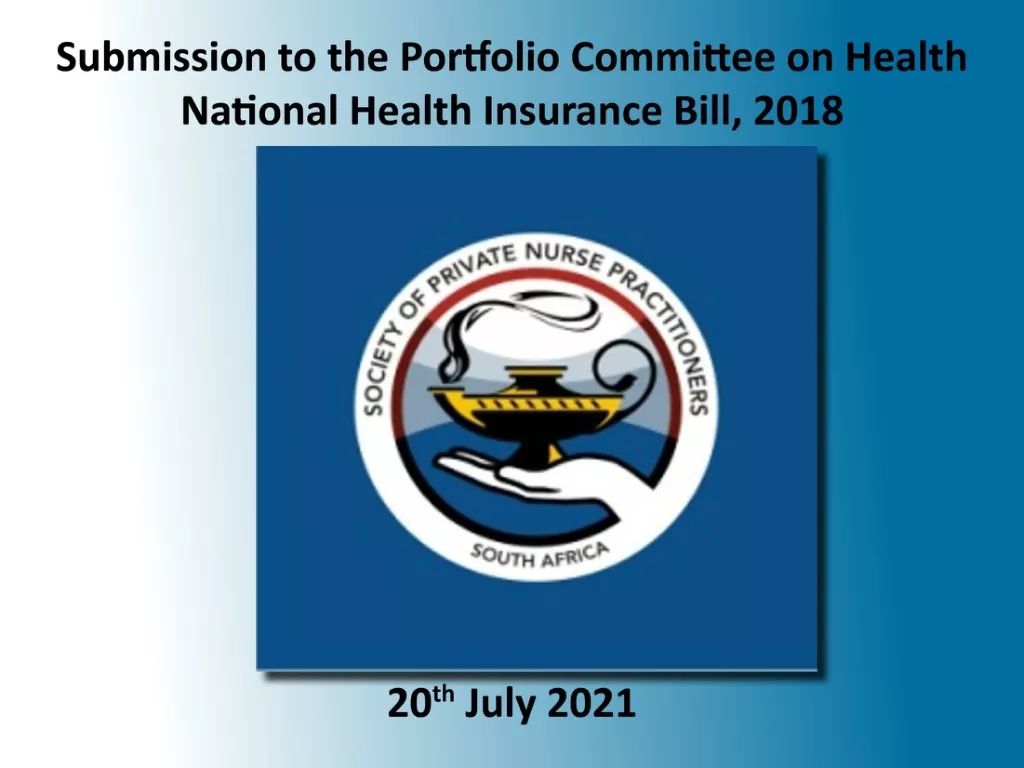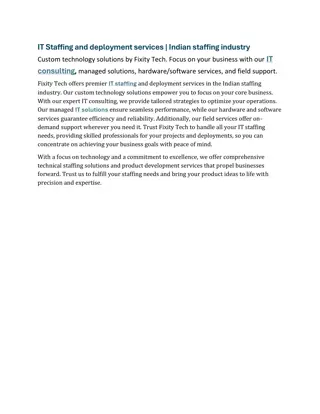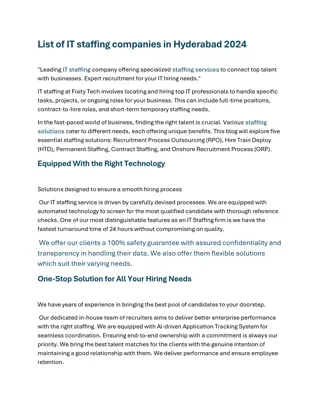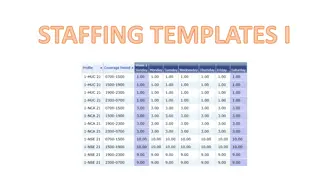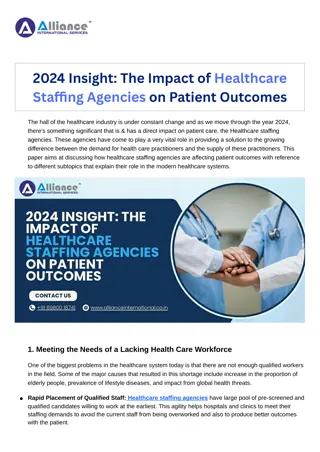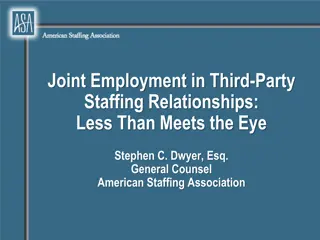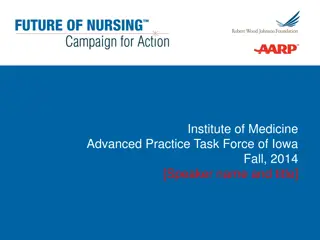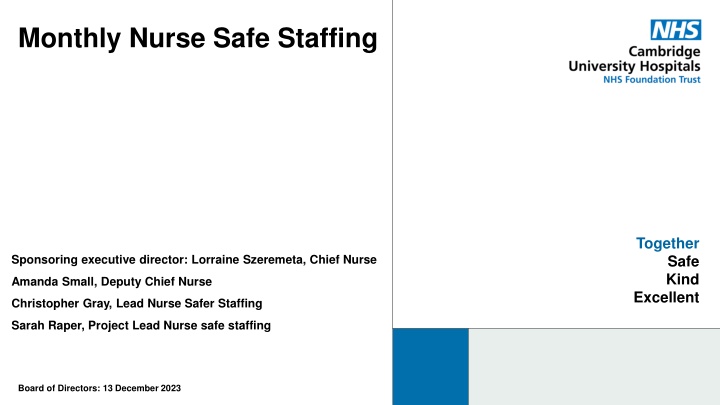
Monthly Nurse Safe Staffing Overview October 2023
Explore the nursing and midwifery staffing report for October 2023, highlighting vacancy rates, turnover, staff availability, and mitigation strategies. Insights into staff redeployment, recruitment, and critical care situations provided.
Download Presentation

Please find below an Image/Link to download the presentation.
The content on the website is provided AS IS for your information and personal use only. It may not be sold, licensed, or shared on other websites without obtaining consent from the author. If you encounter any issues during the download, it is possible that the publisher has removed the file from their server.
You are allowed to download the files provided on this website for personal or commercial use, subject to the condition that they are used lawfully. All files are the property of their respective owners.
The content on the website is provided AS IS for your information and personal use only. It may not be sold, licensed, or shared on other websites without obtaining consent from the author.
E N D
Presentation Transcript
Monthly Nurse Safe Staffing Together Safe Kind Excellent Sponsoring executive director: Lorraine Szeremeta, Chief Nurse Amanda Small, Deputy Chief Nurse Christopher Gray, Lead Nurse Safer Staffing Sarah Raper, Project Lead Nurse safe staffing Board of Directors: 13 December 2023
Executive Summary This slide set provides an overview of the Nursing and Midwifery staffing position for October 2023. The vacancy position in October has decreased in all areas with the exception of maternity care assistants (MCA). For registered children's nurses (RSCNs) the vacancy rate is 20.1% (21.1% in September), Health Care Support Workers (HCSW) 15.4% (15.6% in September), Registered Nurses (RNs) 9.9% (10.6% in September) and Registered Midwifes (RMs) - 0.1% (5.31% in September). The MCA vacancy rate has increased to 25.5% from 21.8% in September. The turnover rate in October remains high but has decreased for RMs (12.15% from 12.9% in September) and HCSW (including MCA s) 16.3% (17.1% in September). However, for RNs turnover has increased slightly to 10.8% (10.6% in September) and RCSN has increased to 15.7% (15.4% in September). The main reason for leaving for RN s,RM s,RSCN s and HCSW s is voluntary resignation relocation. The leavers destination data demonstrates that 27.5% of RNs and 42.4% of RMs are leaving to take up employment in other NHS organisations. 18.2% of RMs are leaving for no employment compared to 8.9% of RNs. Conversely, the leavers destination is unknown for the majority of HCSWs (47%). The planned versus actual staffing report demonstrates that 15 clinical areas reported <90% overall rota fill in October (11 in September). The overall fill rate for maternity has decreased to 88% compared to 90.8% in September. The total unavailability of the workforce working time in October has decreased by 0.9% to 26.6%. The majority of unavailability (12.4%) is due to planned annual leave, sickness absence has remained relatively static in October at 7.7% (7.6% in September). Additionally, 1.2% of working time was unavailable due to other leave, 3.6% was due to study leave and 1.7% was due to supernumerary time. In order to mitigate staffing risks, the number of requests for bank workers remains high with an average of 2740 shifts per week requested for registered staff and 2029 shifts requested for Health care support workers and Maternity support workers per week with an average bank fill rate of 71.61% for registered staff and 61.71% for Health Care Support workers. In addition, the equivalent of 12.9 WTE agency workers are working across the divisions (14.62 WTE in September). Despite this, redeployment of nurses and midwives has remained necessary due to staff unavailability, with an average of 374.62 working hours being redeployed each day of which there is a continued need to redeploy staff out of their division 200 hours in total (760 hours in September). The number of occasions that 1 critical care nurse has needed to care for more than 1 level 3 patient has decreased in October to 7 occasions compared to 79 in September. Additionally, there have been 74 occasions in October where there has been no side room co-ordinator (155 in September). Any concerns with regards to critical care staffing are escalated through the senior nurse of the day. Staffing has been supported through the use of temporary workers (agency and bank), enhanced bank rates and registered staff (non critical care trained) are redeployed from the operational pool and clinical areas on a shift by shift basis. Critical care have opened 3 of the beds that were closed due to staffing resulting in 55 open beds rather than 59 beds. Recruitment is ongoing to the vacant positions with a plan to open the remaining 4 beds when vacancy allows. 2
Combined Nursing and Midwifery Staffing Position Vacancy Rates Graph 1. Nursing and midwifery vacancy rates Vacancy position The combined vacancy rate for Registered Nurses (RNs) and Registered Midwives (RMs) has decreased further to 9.1% in October from 10.1% in September. The vacancy rate for Health care support workers (HCSWs) (including Maternity Care Assistants (MCAs) is static at 15.9% in October (15.9% in September). When broken down further into Nursing and Midwifery specific vacancies, the MCA workforce vacancy rate has increased for October to 25.5% from 21.8% in September. The HCSW vacancy rate (excl MCA) has decreased in October to 15.4% from 15.6% in September. Graph 2. Healthcare Assistant vacancy rates The HCSW (including MCAs) turnover rate remains high and has decreased slightly to 16.3% in October from 17.1% in September. The main reason for HCSWs leaving is voluntary resignation relocation (31.8%) and the next highest reason is voluntary resignation work life balance (26.3%). The leavers destination is unknown for the majority of HCSWs (47%), 15.2% of HCSW s are leaving to take up employment in other NHS organisations and 10.6% are leaving for no employment. 3
Staffing Position Vacancy Rates for Registered Nurses and Registered Midwives Graph 3. Registered Nurse vacancy rates Vacancy position The vacancy rate for Registered Nurses working in adult areas has decreased to 9.9% in October (10.6% in September) as illustrated in Graph 3. The vacancy rate for registered children's nurses has also decreased to 20.1% compared to 21.1% in September. The vacancy rate for Registered Midwives has reduced to -0.1% for October compared to 5.31% in September as illustrated in Graph 4. It should be noted that this reduction in vacancy rate is due to the large number of newly qualified midwives commencing employment and as such there will be a period of time required to consolidate their learning in practice. Graph 4. Registered Midwife vacancy rates The turnover rate in October remains high and has increased to 10.8% for RNs in adult areas (10.6% in September) and to 15.7% for Registered children's nurses (15.4% in September). Conversely, turnover has reduced for RMs to 12.15% (12.9% in September). The main reasons for RMs leaving is voluntary resignation relocation (30.3%) and the next highest reason is voluntary resignation work life balance (24.2%). The main reason for RN s leaving is voluntary resignation relocation (42.4%). The leavers destination data demonstrates that 27.5% of RNs and 42.4% of RMs are leaving to take up employment in other NHS organisations. 18.2% of RMs are leaving for no employment compared with 8.9% of RNs. 4
Unavailability for Registered Nurses, Midwives and Health Care Support Workers Graph 5. Unavailability of staff Unavailability of staff Unavailability relates to periods of time where an employee has been given leave from their regular duties. This might be due to circumstances such as annual leave, sick leave, study leave, carers leave etc. The total unavailability of the workforce working time in October 23 has decreased by 0.9% to 26.6% as illustrated in Graph 5. Graph 6 illustrates the percentage breakdown of the type of unavailability. The majority of unavailability (12.4%) was due to planned annual leave which would have been accounted for in the department rosters. There was a high percentage of unplanned leave that would have impacted upon fill rates within the rosters. In October, sickness absence has remained relatively static at 7.70% (7.60% in September). Other leave has remained static at 1.2%, 3.6% was due to study leave and 1.70% was due to supernumerary time. Graph 6. Types of absence 5
Planned versus actual staffing Overall < 90% RN/RM < 90% HCSW < 90% Planned versus actual staffing Graph 7 illustrates trend data for all wards reporting < 90% rota fill. The number of areas reporting <90% rota fill for registered RN/RM has increased to 13 in October from 11 in September. The number of areas reporting <90% rota fill for HCSWs in October has decreased slightly to 17 from 19 in September. The number of ward areas reporting overall fill rates of <90% in October has increased to 15 compared to 11 in September. Appendix 1. details the exception reports for all areas reporting RN/RM fill rates of <90%. Graph 7 Number of wards reporting < 90% rota fill 30 25 20 15 10 5 The number of occasions that 1 critical care nurse has needed to care for more than 1 level 3 patient has decreased in October to 7 occasions compared to 79 in September. Additionally, there have been 74 occasions in October where there has been no side room coordinator (155 in September). Any concerns with regards to critical care staffing are escalated through the senior nurse of the day. Staffing has been supported through the use of temporary workers (agency and bank) and registered staff (non critical care trained) are redeployed from the operational pool and clinical areas on a shift-by-shift basis. There was also short term agreement to pay critical care trained staff bank enhancement to reduce the over all amount of GPICS breaches. Critical care have opened 3 of the beds that were closed due to staffing resulting in 55 open beds rather than 59 beds. Recruitment is ongoing to the vacant positions with a plan to open the remaining 4 beds when vacancy allows. 0 Oct-22 Nov-22 Dec-22 Jan-23 Feb-23 Mar-23 Apr-23 May-23 Jun-23 Jul-23 Aug-23 Sep-23 Oct-23 RM Graph 8 Rosie Rota Fill % MSW Overall 105 100 95 90 % 85 80 75 70 Oct-22 Nov-22 Dec-22 Jan-23 Feb-23 Mar-23 Apr-23 May-23 Jun-23 Jul-23 Aug-23 Sep-23 Oct-23 Midwifery & MSW fill rate Graph 8 illustrates that the overall fill rate for maternity has decreased slightly to 88% in October form 90% in September which is lower than the 12-month average of 90.9%. The lowest fill rates have been seen on Rosie Birth Centre (79%). 6
Staff deployment Staff deployment Graph 9 illustrates the movement of staff across wards to support safe staffing to ensure patient safety. This includes staff who are moved on an ad hoc basis (shift by shift) and shows which division they are deployed to. The number of substantive staff redeployed has slightly reduced after the increasing trend over 3 months of July to September with 374.62 working hours being redeployed per day in October (388.95 hours in September). This equates to 32.5 long day or night shifts per day. 200 of these hours were redeployments made outside of staff members own division to support patient safety (September 760 hours). Staffing is also being supported by the operational pool whereby bank staff book a bank shift on the understanding that they will work anywhere in the trust where support is required. Nursing Pipeline Appendix 2 provides detail on the forecasted position in relation to the number of adult RN vacancies based on FTE and includes UK experienced, UK newly qualified, apprenticeship route, EU and international up to March 2024. The current forecast demonstrates a year end band 5 RN vacancy position of 5.01% which is slightly above the target of 5%. The RN adult pipeline for 2023/24 now reflects the reduction in international recruitment. This is a national concern and has been escalated to NHS England. Work is being undertaken to explore RN Recruitment initiatives including increasing the International Recruitment pay band and reducing our shortlisting criteria. Appendix 3 provides detail on the forecasted position in relation to the number of Paediatric band 5 RN and HCSW vacancies up to March 2024. Numbers are based on those interviewed and offered positions in addition to planned campaigns. The current forecast demonstrates a year end band 5 Paediatric RN vacancy position of 19.84% and a band 2 HCSW position of 8.15%. Whilst the recruitment pipeline is positive with multiple pipelines including apprenticeship routes, domestic and international recruitment, the predicted numbers are only achievable if the appropriate infrastructure is in place to support. 7
Red flags Red Flags A staffing red flag event is a warning sign that something may be wrong with nursing or midwifery staffing. If a staffing red flag event occurs, the registered nurse or midwife in charge of the service should be notified and necessary action taken to resolve the situation. Nursing red flags Graph 10 illustrates that there has been a increase in the number of red flags reported with 295 reported in October. The highest number of red flags reported in October was in relation to an unmet 1:1 specialling requirement (108 compared with 97 in September). A trust wide improvement project focusing on specialling is being developed to review specialling across the organisation. There has been an increase in 3 reportable red flags in October with the remaining reducing or staying equal. The increases were seen in: Omission of planned mobilisation/washes/obs 32 (14 in September), Delay in pain relief 14 (3 in September) and unmet required nursing skills 79 (46 in September) In, October 2 red flags were reported for less than 2 RN on shift. On further investigation these were raised in error but not resolved. Maternity red flags The number of maternity red flags have seen a decrease from 209 in September to 187 in October. Graph 11 illustrates the red flags that have been reported. The highest number of red flags reported is for missed or delayed care 35.8%. All others have seen a reduction. 23.0% of red flags reported were due to a delay of >30mins between presentation and triage. This is a known area of concern as highlighted in the recent CQC report. 8
Safety and Risk Incidents reported relating to staff shortages Graph 12 illustrates the trend in Safety Learning Reports (SLRs) completed in relation to nurse staffing. In October there were 57 incidents reported compared to 61 in September. The majority of the incidents related to staffing levels in September were reported by division D (16) with the highest reporting area being A4 (5). The highest reporting area for the organisation was NICU with 7. Safety continues to be monitored through the site safety meetings. Care hours per patient day (CHPPD) Care hours per patient day (CHPPD) is the total number of hours worked on the roster (clinical staff including AHPs) divided by the bed state captured at 23.59 each day. NHS Improvement began collecting care hours per patient day formally in May 2016 as part of the Carter Programme. All Trusts are required to report this figure externally. Graph 13: Care Hours Per Patient Day (CHPPD) CUH CHPPD recorded for increased to 8.78 from 8.35 in September. This is below other Shelford hospitals (10.3). In maternity, from 1 April 2021, the total number of patients now includes babies in addition to transitional care areas and mothers who are registered as a patient. CHPPD for the delivery unit in September has increased to 16.78 for October (14.34 in September). 9
Bank Fill Rate and Agency Usage Graph 14 Registered RN/RM Bank fill rate per week Bank fill rate The Trust s Staff Bank continues to support the clinical areas with achieving safe staffing levels. Graph 15 and 16 illustrate the trends in bank shift fill rate per week. Overall, we continued to see a increase in October for bank shift requests for registered staff to mitigate those areas who have less than a rota fill of 90% or to cover an unmet specialling need. The number of requests for registered staff is an average of 2740 shifts per week with an average bank fill rate of 71.61% which is an increase from 70.71% in September. The number of requests for Health care support workers and Maternity support workers remains high with an average of 2029 shifts per week with an average bank fill rate of 61.71% this is a slight decrease from 63.63% in September. Graph 15 HCSW/MSW bank fill rate per week In addition to bank workers we have the equivalent of 12.9 WTE agency workers working (14.6 WTE in September) across the divisions to support staffing challenges in the short term. This agency usage had been reducing but to support the emergency department and critical care there has been a need to increase to support safe staffing. Short term pay enhancements for bank shifts put in place earlier in the year to encourage a higher uptake of shifts had been reduced in July with these now only being targeted to those areas with the highest vacancy. There has been a slight reduction in bank fill in correlation with this but not a significant decrease. This trend will continue to be monitored. Any bank enhancements in place are reviewed regularly (at least on a 6 weekly basis) through the weekly bank enhancement meeting and are for fixed periods of time. 10
Appendix 1: Exception report by Division Oct-23 Unit Speciality % fill registered % fill care staff Overall filled % CHPPD Analysis of gaps Impact on Quality / outcomes Actions in place sickness at start of month was ~10% by the end was 6.5% and improving GPCI breaches each week- at the start of the month 37 by end of October 11 (with a low of 5 breaches total midmonth) Ongoing recruitment and sickness management GPIC Breaches. Potential delays to patient care and patient flow. Reduced supervisory time to mitigate may be considered. Reduction NQM and KPI's. Staff morale, retention of staff. Poor patient experience. Lack of ability to be pre emptive due to clinical acuity. Workload absorbed by DSU staff on duty. This could result in delays to first patients being prep'd for theatre or at the end of the LD when the team is discharging day cases- when activity is high. This could also result in delays in care/assisting contingency patients as well as post op patients and cleaning bays, prepping for tomorrow's TCIs Raised at 08:15 and daily bronze, circulation of capacity and breaches list. Discharging wardables. PD and band 7s in numbers, requesting bank enhancements, managing sickness. Escalating at Ops meeting 192 - CRITICAL CARE MEDICINE - RISK MANAGED Divisio n A 28.21 88% 96% 90% JOHN FARMAN ICU Cap of pt being sent to DSU as contingency. Review of staffing required for following week on Wednesday afternoon. Redeployment of other HCAs and request for support from Ops pool. Vacancy of 6.4 wte (b2+B3s) with 4 posts under offer Divisio n A 91% 81% 91% HCA fill rate at 81% Day Surgery Day Surgery 164 outbound hours; 315 inbound hours 2 red flags; 1 omission of planned mobilisation/washes; 1 unmet nursing skills 77 unfilled RN shifts 116 unfilled HCSW shifts 21% roster unfilled 22 incidents, 0x mod+ harm Highest category: Fall (5) 1x HAPU - SDTI 0x patients with more than 2 incidents Daily divisional mitigation; site safety escalation; weekly prospective staffing reporting and mitigation; divisional recruitment and retention strategy. Matron quality focus. Divisio n C 361 - NEPHROLOGY - PROTECTED 7.00 84% 95% 88% C5 11
Speciality Unit % fill registered % fill care staff Overall filled % CHPPD Analysis of gaps Impact on Quality / outcomes Actions in place 83 outbound hours; 101 inbound hours 0 red flags raised 25 unfilled RN shifts 8 unfilled HCSW shifts 9% roster unfilled High unused contracted hours 251 inbound hours; 310 inbound hours 1 red flag; unmet nursing skills 61 unfilled RN shifts 78 unfilled HCSW shifts 16& roster unfilled High unused contracted hours 148 outbound hours; 443 inbound hours 5 red flags; unmet 1:1 specialling 37 unfilled RN shifts 146 unfilled HCSW shifts 25% roster unfilled High unused contracted hours 285 outbound hours; 383 inbound hours 0 red flags 49 unfilled RN shifts 86 unfilled HCSW shifts 16% roster unfilled High unused contracted hours 143 outbound hours; 711 inbound hours 5 red flags; 1 more than 25% shortfall in RN; 2 omission of planned mobilisation/washes; 1 unable to facilitate staff break; 1 unmet 1:1 specialling requirement 83 unfilled RN shifts 77 unfilled HCSW shifts 24% roster unfilled 6 incidents, 0x moderate or above harm Highest category: falls and medication 0x HAPU 0 patients with more than 2 incidents Daily divisional mitigation; site safety escalation; weekly prospective staffing reporting and mitigation; divisional recruitment and retention strategy. Matron quality focus. 350 - INFECTIOUS DISEASES - RISK MANAGED Divisio n C 7.21 89% 94% 91% D10 27 incidents, 1x mod+ harm: HAPU cat 2 Highest category: Fall (9) 2x HAPU- SDTI (1), Cat 2 (1) 0 patients with more than 2 incidents Daily divisional mitigation; site safety escalation; weekly prospective staffing reporting and mitigation; divisional recruitment and retention strategy. Matron quality focus. 300 - GENERAL MEDICINE - STANDARD Divisio n C 7.81 90% 94% 91% EAU 4 7 incidents, 0x mod+ harm Highest category: medication (2) 0x HAPU 0x patients with more than 2 incidents Daily divisional mitigation; site safety escalation; weekly prospective staffing reporting and mitigation; divisional recruitment and retention strategy. Matron quality focus. 300 - GENERAL MEDICINE - RISK MANAGED Divisio n C 7.86 89% 116% 100% F4 15 incidents, 1x mod+ harm: severe harm Unstageable HAPU Highest category: Fall (4) 2x HAPU- unstageable (1), SDTI (1) 0x patients with more than 2 incidents Daily divisional mitigation; site safety escalation; weekly prospective staffing reporting and mitigation; divisional recruitment and retention strategy. Matron quality focus. 300 - GENERAL MEDICINE - STANDARD Divisio n C 6.59 89% 102% 95% G4 17 incidents, 1x mod+ harm, HAPU cat 2 Highest category: moisture lesion and falls and PU (3) 1x HAPU- cat 2 (1) 0x patients with more than 2 incidents Daily divisional mitigation; site safety escalation; weekly prospective staffing reporting and mitigation; divisional recruitment and retention strategy. Matron quality focus. 300 - GENERAL MEDICINE - RISK MANAGED Divisio n C 8.48 85% 98% 90% N2 12
Oct-23 Unit Speciality % fill registered % fill care staff Overall filled % CHPPD Analysis of gaps Impact on Quality / outcomes Actions in place 6 incidents, 0x mod+ harm Highest category: diagnostics/investigations (2) 0x HAPU 0x patients with more than 2 incidents 2 incidents, 0x mod+ harm Highest category: both transfusion and diagnosis 0x HAPU 0x patients with more than 2 incidents Divisio n C Matron oversight and mitigation from within where possible. Escalation to DDHON. Daily divisional mitigation; site safety escalation; weekly prospective staffing reporting and mitigation; divisional recruitment and retention strategy. Matron quality focus. Daily divisional mitigation; site safety escalation; weekly prospective staffing reporting and mitigation; divisional recruitment and retention strategy. Matron quality focus. Daily divisional mitigation; site safety escalation; weekly prospective staffing reporting and mitigation; divisional recruitment and retention strategy. Matron quality focus. 73% 73% ENP (EAU) EAU ENPs 38 unfilled registered shifts 19% roster unfilled 224 outbound hours; 153 inbound hours 1 red flag; unmet nursing skills 7 unfilled RN shifts 37 unfilled HCSW shifts 14% roster unfilled Medical Ambulatory Care Unit Divisio n C 69% 78% 72% Assessment Unit No Impact on NQM as staffing is mitigated through SSM and within the division by redeploying staff from areas with capacity Divisio n D 320 - CARDIOLOGY - STANDARD 90% 93% 91% 5.43 K3 can be dependent on sickness levels, acuity and bank fill rate (or lack of bank fill) No Impact on NQM as staffing is mitigated through SSM and within the division by redeploying staff from areas with capacity 300 - GENERAL MEDICINE - PROTECTED Divisio n D 85% 96% 90% 6.24 L5 Vascular can be dependent on sickness levels, acuity and bank fill rate (or lack of bank fill) current RN vacancy 9.87% = 3.76wte 1.0wte in pipleine out and 5.0wte in pipeline in leaving net position of 0.24wte to fill Current RN vacancy 12.97% 5.0wte in pipeline in leaving net position of 1.87wte RN vacancy to fill Current RN vacancy 16.8% 4.0wte in pipeline in which wil leave net position of 0wte RN positions to fill. Divisio n E 420 - PAEDIATRICS - STANDARD regular review of staffing levels, quality & safety on ward 88% 137% 95% 10.62 C2 no impact on NQM Divisio n E 420 - PAEDIATRICS - PROTECTED regular review of staffing levels, quality & safety on ward 10.97 81% 118% 91% C3 no impact on NQM 171 - PAEDIATRIC SURGERY - PROTECTED Divisio n E regular review of staffing levels, quality & safety on ward 77% 95% 83% 6.73 F3 COU no impact on NQM Divisio n E 501 - OBSTETRICS - RISK MANAGED Target CHPPD achieved, suggesting safe staffing 4.61 89% 75% 83% Lady Mary Skills mix with junior workforce, increased acuity. Divisio n E Nursing and Midwifery Target CHPPD achieved, suggesting safe staffing 89% 100% 93% C.A.R.E.S Team Skills mix with junior workforce, increased acuity. 13
Appendix 2: Adult RN Recruitment pipeline Adult band 5 RN position based on predictions and established FTE (60% of graduates) Nursing Associates Anglia Ruskin NQ Return to Practice Promotions and transfer out of scope- retained by the trust UK based exp. Vacancy rate based on established FTE No. of vacancies based on established FTE applicants Other NQ ESR Starter leaver variance Total New Starters Staff in post FTE NAP Month Overseas Leavers FTE Establishme nt FTE 5 1 4 1 3 7 1 6 6 7 3 5 2 3 12 5 2 9 28 21 22 23 20 47 54 38 75 52 40 74 569 9 11 12 13 10 10 7 12 14 15 15 15 15 149 1534 1529 1531 1528 1753 1777 1635 1644 1691 1715 1727 1773 1773 1699 1699 1699 1699 1931 1951 1759 1828 1828 1828 1867 1867 1867 9.70% 10.01% 9.89% 10.06% 9.20% 8.90% 7.05% 10.06% 7.49% 6.18% 7.48% 5.01% 5.01% 165 170 168 171 19 7 15 7 9 31 40 23 62 39 27 61 340 Apr-23 May-23 Jun-23 Jul-23 Aug-23 Sep-23 Oct-23 Nov-23 Dec-23 Jan-24 Feb-24 Mar-24 TOTAL 12 16 19 16 35 40 28 49 40 35 35 334 14 7 16 11 16 14 15 13 13 13 13 154 1 1 3 2 177.64 173.64 124.01 183.91 136.91 112.91 139.61 93.61 93.61 2 2 11 4 4 3 16 2 2 27 59 7 49 13 2 35 2 14
Appendix 3: Paediatric RN and Band 2 HCSW Recruitment pipeline Band 2 HCSW position based on predictions and established FTE Apprenticeship Vacancy rate based on established FTE 13.42% 12.63% 13.42% 14.32% 15.67% 14.93% 14.72% 16.61% 16.40% 13.99% 11.63% 8.15% 8.15% No. of vacancies based on established FTE (direct entry) Apprentices UK based Associate applicants Nursing Total New Starters FTE ESR Staff in post FTE Month Leavers FTE Establishm ent FTE 18 16 20 14 11 25 28 33 10 30 30 30 265 1 1 5 3 1 2 2 3 2 19 17 25 17 12 27 30 36 15 36 56 47 337 18 10 7 16 17 12 8 13 13 13 13 13 153 768 775 768 760 741 756 772 795 797 820 863 897 887 887 887 887 878 888 905 953 953 953 976 976 119 112 119 127 138 133 133 158 156 133 114 80 79.6 Apr-23 May-23 Jun-23 Jul-23 Aug-23 Sep-23 Oct-23 Nov-23 Dec-23 Jan-24 Feb-24 Mar-24 TOTAL 3 6 26 17 52 20 896.8 976.4 15

